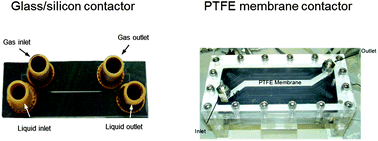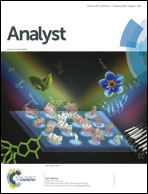Stripping of acetone from water with microfabricated and membrane gas–liquid contactors
Abstract
Stripping of acetone from water utilizing nitrogen as a sweeping gas in co-current flow was conducted in a microfabricated glass/silicon gas–liquid contactor. The chip consisted of a microchannel divided into a gas and a liquid chamber by 10 μm diameter micropillars located next to one of the channel walls. The channel length was 35 mm, the channel width was 220 μm and the microchannel depth 100 μm. The micropillars were wetted by the water/acetone solution and formed a 15 μm liquid film between them and the nearest channel wall, leaving a 195 μm gap for gas flow. In addition, acetone stripping was performed in a microchannel membrane contactor, utilizing a hydrophobic PTFE membrane placed between two microstructured acrylic plates. Microchannels for gas and liquid flows were machined in the plates and had a depth of 850 μm and 200 μm respectively. In both contactors the gas/liquid interface was stabilized: in the glass/silicon contactor by the hydrophilic micropillars, while in the PTFE/acrylic one by the hydrophobic membrane. For both contactors separation efficiency was found to increase by increasing the gas/liquid flow rate ratio, but was not affected when increasing the inlet acetone concentration. Separation was more efficient in the microfabricated contactor due to the very thin liquid layer employed.


 Please wait while we load your content...
Please wait while we load your content...